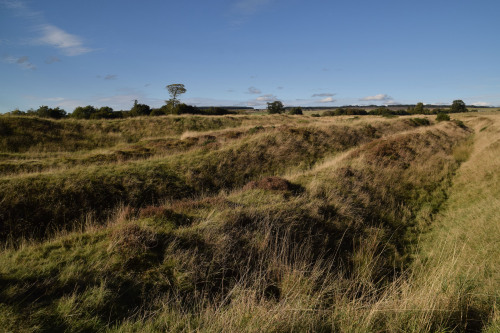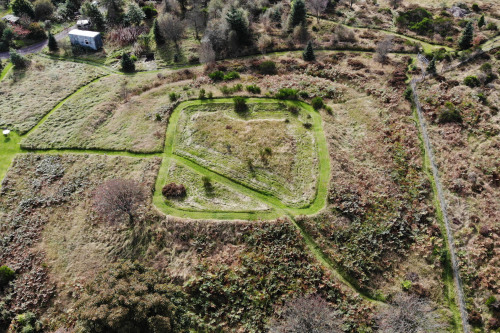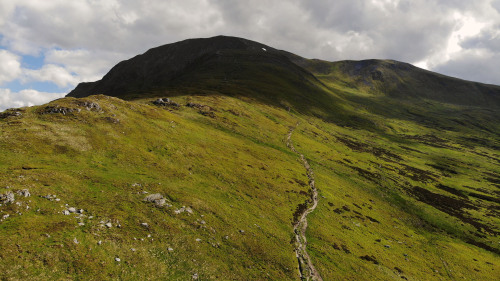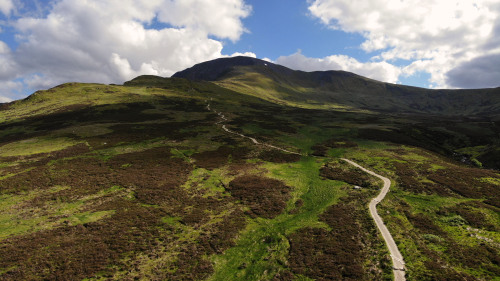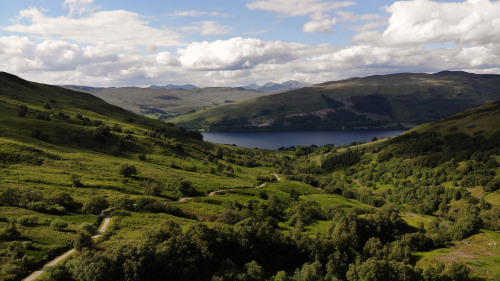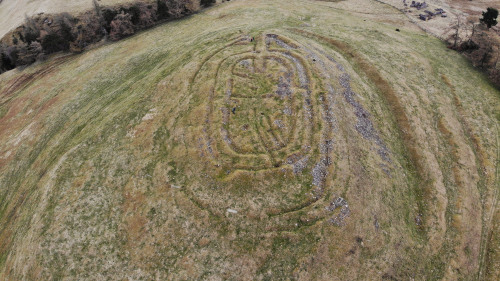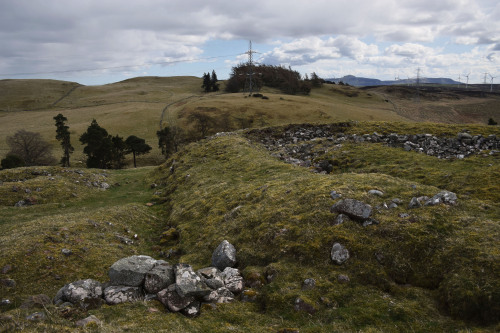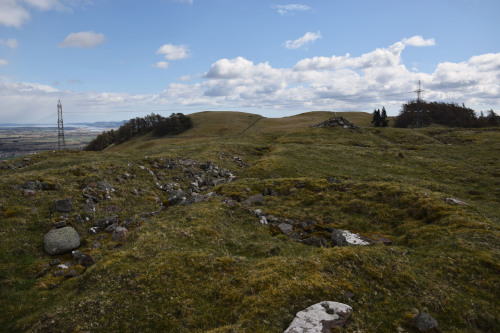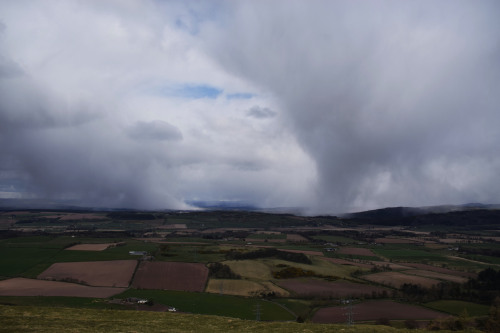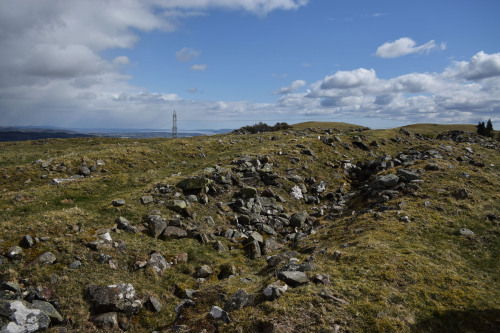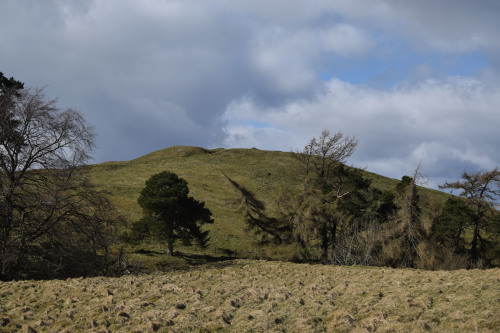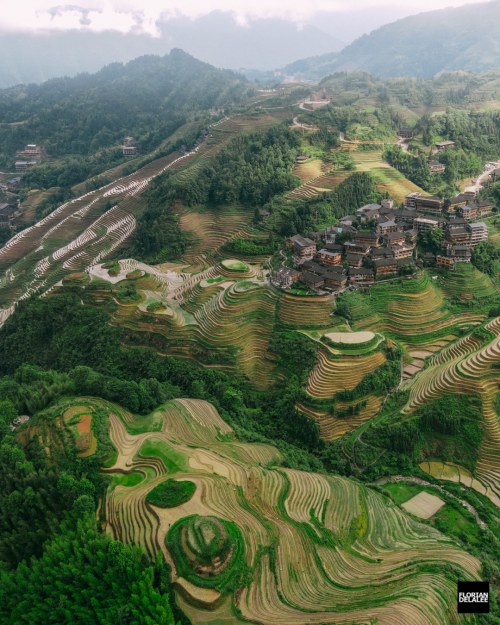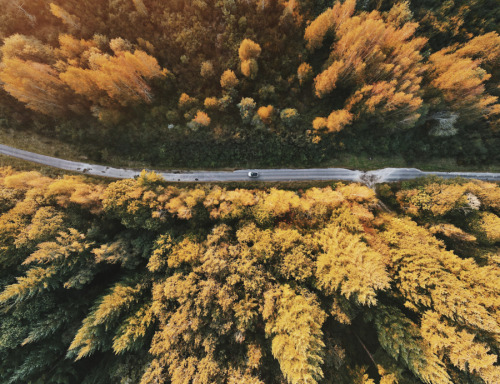#drone photography
Ardoch Roman Fort, Kaims Castle Roman Fortlet and Muir O’ Fauld Watchtower | Gask Ridge, Perthshire
We visited a few places along the Gask Ridge, the Roman frontier that was established during their first campaign in Scotland in the 1st Century AD, led by Agricola. He established temporary marching camps all the way up to Inverness, but the forts on the Gask Ridge were built to last (as you can see Ardoch has lasted until now). They form a line running along the Highlands in safe distance, with some ‘Glenblocker’ forts sitting on the entrance of the glens to give warnings of raids. After the Battle of Mons Grapius in 83 AD, where the Scottish tribes faced the Romans head-on and lost badly, the tribes would pretty much only use guerrilla tactics, hiding in the mountains and forest and raiding Roman camps when they least expected it. The occupation of the Gask Ridge lasted hardly a decade before the Romans abandoned this frontier. Though two more attempts were made in the centuries to come (the Antonine Wall was built during the 2nd attempt) and Ardoch was re-used and re-built both times. That is perhaps why it is so well-preserved and from up in the air you can still see the older, oblong fort underneath the second square-shaped they built on top (1st picture). Fortlets were slightly smaller forts to bridge the distance between the large Forts and Watchtowers filled in the rest of the line, so that there was something every 1-1.5 km and a signal (for example beacons of smoke) could be relayed swiftly between the main camps. In addition, the large forts were always situated near a river. You can tell that the Romans had their strategy down. And yet, they never gained a foothold in Scotland. Head over to Youtube for our visit of the Gask Ridge, which ended up being a mini-documentary, if you want to dive deeper into the history of the Romans in Scotland.
Post link
Ben Vorlich and Loch Earn
I brought my drone along for a mountain walk because I wanted to see the mountain from up above. I have always loved flying on planes because I get to see the world from a bird’s perspective. Now that I can fly a drone, I am yet one step closer to bird vision.
Post link
Castle Law, Forgandenny
This Iron Age-style hillfort has been excavated in Victorian times and since then the walls at the top have been exposed, creating this fascinating pattern. From the ground all we could see was parallel lines, but from the air this hillfort truly comes to life. It is a timber-laced hillfort, just like the nearby Castlelaw near Abernethy, a technique which originated in Switzerland according to some archaeologists and may reflect an influx of incomers to the British Isles from the continent. There’s a full hillfort tour up on my channel.
Post link

Corfe Castle, England - by I Am Sean Photography

Off Patras’ marina by @nikoskotsokolos on Instagram.

Our van wheels crunched over unpaved road after unpaved road, kicking up mud and gravel as we bumbled along a series of winding dirt tracks which wove their way through endless pine forest.
This was the face of Bosnia & Herzegovina’s interior, a world away from the bustle and bullet-strewn concrete structures of its capital Sarajevo. Here, pretty little stone houses were strewn across scenic plateaus which seemed to appear mysteriously out of the dense thicket of trees that surrounded them and crept up to their doorsteps. Wild animals were known to roam these forests, and we wondered how humans could live so close to them without conflict.
We were still carving our route home out, ever Northbound, savouring these last few days in the Balkans before we would hotfoot across Europe back to England. We slept soundly that night, cradled by the forest, and coaxed our van into life with jackets bundled against the icy morning air. This was our pattern of travel these days; squeezing the most of every moment, battling with our van to get it home, the road our only constant as we went.⠀
As the forest dwindled and eventually gave way to civilisation we followed a winding little road partially covered by snow up to a ledge, where we spent the night sleeping underneath the remnants of Tito’s fist. Now a crumbling concrete structure, this bizarre object known as a spomenik had once been a monument to the Partisan soldiers who fought in the Battle of the Wounded in the valley below, but was nicknamed for its uncanny resemblance to Yugoslavia’s former leader ad the iron fist with which he ruled. However, shortly after the Bosnian War, a group of vandals planted dynamite inside and blew it to pieces, although its skeleton still dominates the skyline for miles around.
We were beginning to understand more of Bosnia’s chequered past, evident in every bullet-strewn building and every crumbling ruin we passed. Twenty years was not enough time to heal, but even after the visible reminders had long since been repaired, the memories would not fade for generations yet to come.⠀
⠀
Driving through the snow-covered mountains which encircled Sarajevo, it was hard to imagine this beautiful area as a war zone, even less so one that had existed in our lifetimes. Yet the scars leftover from the war were omnipresent; they were in every bullet hole-strewn building, in every road surface struck by a mortar, in every man who hobbled past us on wooden crutches. We had arrived in Bosnia & Herzegovina with the intention of seeing beyond its past, but found it quite impossible to ignore.
Perhaps most poignant of all the lingering remnants of war were Sarajevo’s abandoned Olympic venues; the bobsleigh track once filled with spectators, now a crumbling relic; the angular lump of concrete that was Hotel Igman, whose rooms had not been filled since the siege began. Most chilling of all perhaps, were the former Olympic ski jumps, located on the buffer zone across Igman ridge, laced with mines and used as a site for executions.
As our boots crunched through deep snow only the eerie silence in the air betrayed the area’s dark history. We’d spent the night at Hotel Igman, although not as its designers had intended; we’d camped up in what would’ve been its car park, or so we had presumed as it was buried under a foot or so of snow. Having woken up to find the bobsleigh track and surrounding pine trees painted white the previous morning, it gave us an enormous sense of comfort that the mountains on the opposite side of Sarajevo were also covered. This would be the last snow we’d see for many months, dusting the communist concrete structures and turning them into things of beauty, the snow and infinite forest of pine trees muffling all sounds as we slept beneath a blanket of white.
But now the snow was melting, icicles dripping all around us and soaking into our boots as we explored the remnants of Sarajevo’s ski jumps. It seemed metaphorical almost of our time in the Balkans; simplistically beautiful, all too brief and now slowly coming to an end.
We had just a few more days in Bosnia before our compass would point us North, and we would make our reluctant return into Western civilisation.
Post link

Our arrival in Bosnia & Herzegovina came as a pleasant surprise.⠀
After following the craggy walls of the mighty Tara Canyon all the way through Montenegro it led us straight into the capital city of Sarajevo. We weren’t here to see the war ruins, nor had we come to try and find the best burek (although that was debatable). No, with just seven short days in this intriguing country that was once one of the most fundamental parts of the Yugoslav Republic, there was only time to explore one thing: the remains of Sarajevo’s Winter Olympics venues.
We pulled up after a long day of inter-country driving, arranging of SIM cards and fawning over foreign foods in a new supermarket, next to a long, snaking and heavily graffitied piece of concrete. We’d seen photos of the abandoned bobsleigh track online but never for one minute did we imagine we could drive into it, let alone camp. The place was perfectly secluded amongst the pine trees, at the top of a mountain which gave a spectacular view over the city. As night fell we rested underneath the Sarajevan sky now studded with stars.
Come morning we noticed a distinct chill in the air, and threw open the door to discover a blanket of snow all around us. We’d had no inkling snow was coming, and had been lamenting the day before how incredible it would’ve been to see the bobsleigh track as it was during the 1984 Winter Olympics.⠀
We bundled on our boots in pure excitement and piled out of the van to make tracks in the fresh, untrodden snow and explore the lengths of the snaking concrete track which wound its way in and out of the pine forest. At times we were completely hidden by trees, shrouded in fog, appearing at regular intervals in view of a road or a place where spectators would’ve gathered in years gone by before the war changed the face of Sarajevo forever.
Fingers suitably numbed, we headed back into the van to warm them with coffee.

, , , …
Our boots crunched over loose, rocky scree and a vertical incline that threatened to topple us over at any minute. The track we were following was unlike anything we’d hiked before; less a path and more a trail carved out by the resilient villagers who lived at the top of this mountain.
We had journeyed to the Northernmost corner of Albania until the road could take us no further; here we left the van and met our guide who would take us to meet the villagers living in some of Albania’s most remote regions, places only accessible on foot or by mule.
At this altitude in the Albanian Alps there was no vegetation, nothing to suggest this area would support life; the closest thing to trees were the makeshift poles supporting a thin electricity wire than ran from the bottom of the valley to the peak above us. We followed the path arduously, gasping for breath and legs screaming in protest while our guide, who’d been traversing these mountains since he learned to walk, sailed ahead of us.
Men twice our age passed us with ease, taking their mules to the top to fetch hay, and we doubted whether we’d ever make it to the end of this 2km near-vertical climb.
But then, mercifully, the ground began to level out, and a luscious green pasture spread out before us, covering the plateau. This was the last place on earth we’d expected to see people living, yet unbelievably a dozen or so houses were spread out across the vast fields where horses and sheep grazed.
It took another hour or so to reach a homestead which looked like it might be inhabited; many of the rest were crumbling ruins, long abandoned as their owners headed for the city. A middle-aged woman greeted us at the door, wearing a white head scarf and modest clothing; she was clearly surprised and excited to have visitors. She immediately invited us inside for coffee, and set about pouring glasses of rakia from a bottle shaped like a crucifix.
We were in awe of her home, which was furnished with beautiful polished wood items and an ornate wood burner in the center. We inquired how she had managed to get it up here, and she recalled hauling it up the same track we had taken, carrying it on sticks along with her husband on their shoulders. The same would’ve been true for every item of furniture in their house, making this otherwise ordinary house suddenly look quite impossible.
After drinks, Age (Aga) happily showed us around her property; she had vegetables and dried mountain herbs in her larder, dried cuts of meat in her barn. She kept sheep for their milk, churned this by hand to make butter, and knitted clothes and rugs from their wool. Her water came from a spring and her income came from raising cattle. Every part of her life was fascinating to us; our minds boggled at the length and difficulty of the journey we had taken, hours from the nearest city with amenities, right up to this woman’s house that would be ordinary if not for its exceptional location atop a mountain.
It was still incomprehensible, even though we’d completed the journey ourselves, and we imagined her and her husband making their monthly trip to Shkodër then hiking back up the vertical path with their supplies; it was a world away from simply visiting the supermarket. From this vantage point we could see dozens more houses scattered across the mountains in even more unlikely places, and we were curious whether anyone still lived in them and what their stories were.
We said goodbye to Age, who still had much work to do before the sunset, and began our painstaking journey down the other side of the mountain left in complete and total awe.
This is an excerpt from an ongoing documentary project about the residents of the Albanian Alps, one of the most inaccessible regions of Europe. The video of this adventure will be out on YouTube on Sunday, and the full photo essay will be available to view on @lbjournalssoon.

The distant sounds of the Call To Prayer rang out across the steely waters of Lake Skadar, crackling out through distorted speakers atop the minarets of several mosques, clashing and vying for dominance like the howling of street dogs. The sky was reflected in the glassy lake surface as it turned slowly from blue to purple to an electrifying red which set the clouds ablaze. And we were making our preparations to head deep into the mountains.
We’d been parked up amongst the waterlogged trees and lake reeds for several days, a furtive little spot accessible by driving through a shallow river that had swollen to twice its size following the rainfall on the day we arrived. But now the blissful sunset colours cast down onto the distant mountains of Montenegro and all was calm in the far North of Albania again.
Of all the lakes we’d camped by in recent months, Lake Skadar was easily the largest and most impressive.⠀
While we’d stuck religiously to our inland route around the Balkan Peninsula these lakes gave us some comfort and a gentle reminder of the ocean’s edge we’d left behind in search of provincial adventures. Although we’d grown up a stone’s throw from the sea and these country’s coastlines provided an easily navigable and scenic route, we’d been drawn to see more of Europe’s hinterlands, a world away from glitzy seaside resorts and tourist attractions. In the heartlands of Albania we’d discovered spectacular mountainscapes, empty lands, impassable roads and an authenticity, warmth and unrivalled hospitality from its people. The same was true of the Balkans’ whole interior, and in fact we’d only briefly touched the sea in Thessaloniki since our departure from Calais many months prior.
These lesser-visited areas are what we live for; places you won’t find in any guidebook, unblemished of tourist attractions. Just raw and honest countryside, nothing more.⠀
We finished packing up our backpacks just as the last of the light was fading, ready for our journey tomorrow into the most remote corner of this country. ⠀
⠀

When it rains in the mountains, it really rains. Not a fine mizzle or the odd shower like we get in England, but a biblical, all-engrossing rain that pelts down from the sky and sends rivers running down the mountainsides in great waterfalls that flood the roads and make planning any sort of activity quite impossible.
Such is the unpredictability of the Accursed Mountains, a corner of Albania whose curious histories and unique way of life woven amongst its limestone peaks will forever keep us coming back for more.
This fascinating mountain range was so named for its wildly inhospitable conditions, and is one of the rare mountain ranges in Europe that is yet to be fully explored. But mountaineers with their compasses and maps will never truly conquer these mountains, for the only way to truly navigate them is with a lifetime of muscle memory, ingrained into mountain men from the age they learn to walk. There are few roads, no signposted trails, and no forgiveness; if you get lost and the weather doesn’t get you then the wolves surely will.
But while the mountains may ward you off with their inhospitality the people will surely not, as they are perhaps some of the warmest and most welcoming in all the Balkans. With no fear of strangers and no reason to lock their doors some three hours away from the nearest town, they will happily invite you into their home for a coffee and a rakia before you continue on your journey.
The Albanian Alps possess a deep sense of mystery that fascinates us and seems almost tangible as we pull off the craggy SH25 alongside the Drin river, unwilling to drive any further in the torrential downpour. The thunderstorm would not pass until tomorrow evening when we would be rewarded with another spectacular Albanian sunset, but before that we would endure a night of lightning strikes powerful enough to knock out the area’s only phone mast, and thunder that shook us violently inside our van; if you’ve never heard thunder in the mountains before, imagine someone dropping about thirty dustbins off the side of a cliff at once. It booms.
It felt all at once overwhelmingly exciting and familiar to be back in the North of Albania once again, parked up so close to an area we’d become so affiliated with that had played home to one of our favourite travel stories. But now we were about to make more, as we were set to be heading off the road and into the furthest reaches of these mountains on foot, a place where vehicles could only dream to go and mules were the primary mode of transport.
Soon we were going back into the heart of the Accursed Mountains.

Isolated.
Few places offer such opportunity to seek the wild and the remote such as North Albania.
A swathe of black pine trees, a horizon dominated by the hostile white peaks of the Accursed Mountains, and a winding dirt track meandering toward a wide open plateau just big enough for one van to camp. This is where we spent our nights while our days were spent in nearby Pukë.
Of course, parking in such remote places is usually fraught with a danger we must weigh up and assess before deciding to stay. And with our van playing up in cold weather since driving the perilous SH75 road we knew this was a risk we would take.
Dusk arrived, staining the valleysides purple and tinting the dry grass a beautiful shade of umber. The starlit night was peaceful and undisturbed by another human presence, but by dawn the winds had began to pick up, descending from a mountain whose name we were later told translated to the .
Our sleep interrupted, we cracked our eyes open and lay in bed while the van rocked to and fro until one of us gave in and got up to move it to a sheltered spot. Unfortunately, with the wind blasting straight into the engine, the stubborn old beast refused to start and we were left stranded, watching the hammocks and the lights sway as though in an earthquake.
Thankfully we were rescued, for the first in a number of times that week, by @discover_puka in a Land Rover. With our van running at last we were able to drive into the town to wander round its beautiful square and little tiny shops, and sample some of the local Puka beer made from the surrounding area’s mountain spring water.
Then we returned to our secluded spot amongst the pines to rest for the following day’s adventure, safe in the knowledge that even the most troublesome days in the wild were bound to make a good story one day.

Alone in the wild.⠀
⠀
We can never truly be alone, no matter how remote we go in our van. Because if we can drive it, someone else can too.⠀
But still we like to find these hidden crevices, areas of land with no purpose and no reason to visit them. We like to tuck ourselves so far out of the way we might not see another person for days, for reasons we can’t explain.⠀
It’s difficult to put into words, my desire to meet people and hear their stories in every corner of the world we go, and the yearning to conceal ourselves away like some childish game of hide and seek, except no one’s going to come looking.⠀
I can’t explain it, but I find solace in knowing I’m not the only one.⠀
In a particular chapter of a very well-known book Jon Krakauer finds himself climbing to the top of an Alaskan mountain so remote it hasn’t seen a visitor in years, risking his life in the snow, all in the name of solitude. The lengths he would go to to escape humankind, and the loneliness that struck him once he was back amongst them- that story sticks in my mind, always.⠀
Some may find unabounded silence and space unnerving, the knowledge that if something goes wrong you’re stuck out here. But we relish in it, the what if’s outweighed by the bliss of isolation. The possibility that maybe, just maybe, not one person has ever camped in this spot before and we might be the first.⠀
The solitude quells our minds as much as it unnerves them, but still the excitement of adventure keeps us pushing onwards into evermore distant corners of the earth.⠀
P.S. Can anyone name the book?

Standing on the edge of the world with you.
We’re missing camp spots like this one in Albania as we self-isolate back in Cornwall after a nightmare drive getting back, but we still have many weeks worth of photos and travel stories to share with you all that will hopefully brighten your days.
Tell us what you’re up to if you’re self-isolating- we’re working on our huge backlog of travelogues for YouTube, repairing the many problems with our van and drinking countless cups of Yorkshire tea! ☕️




